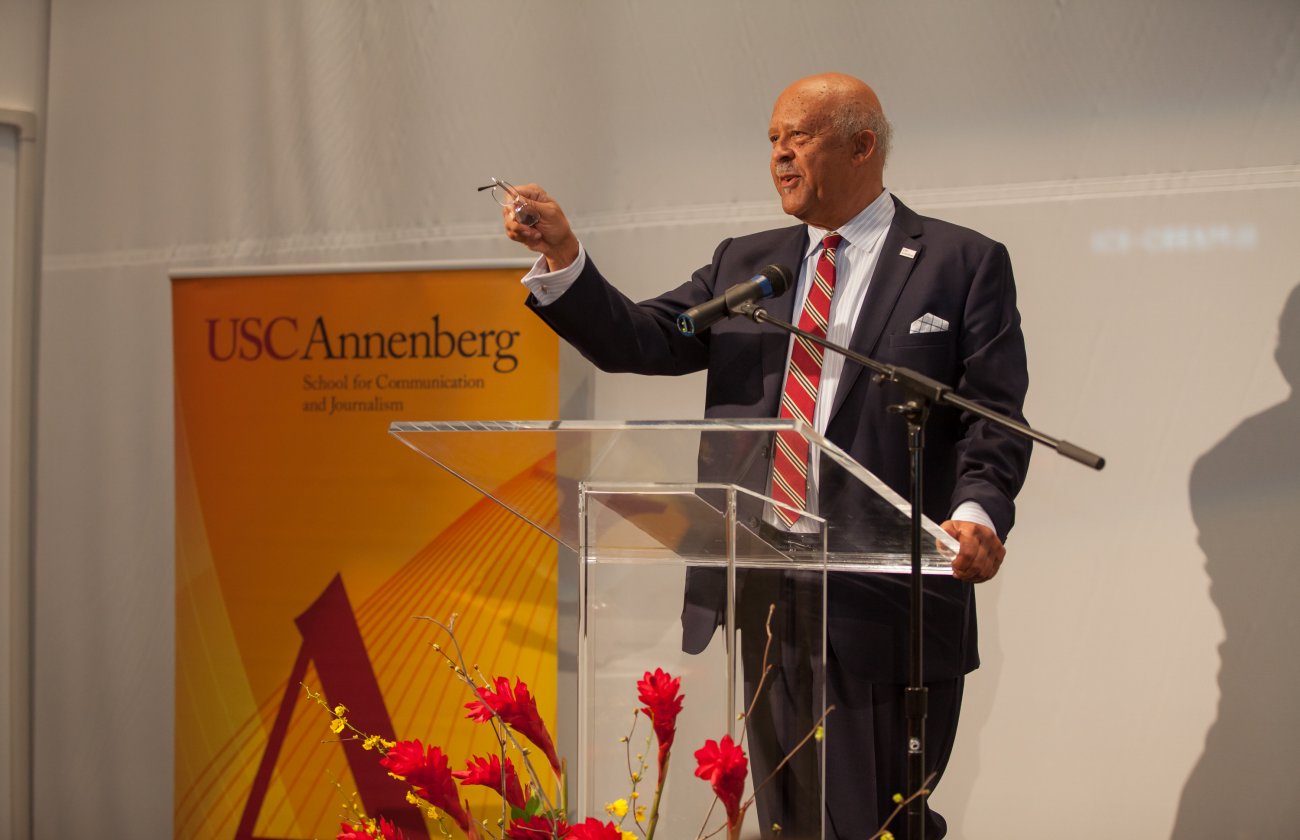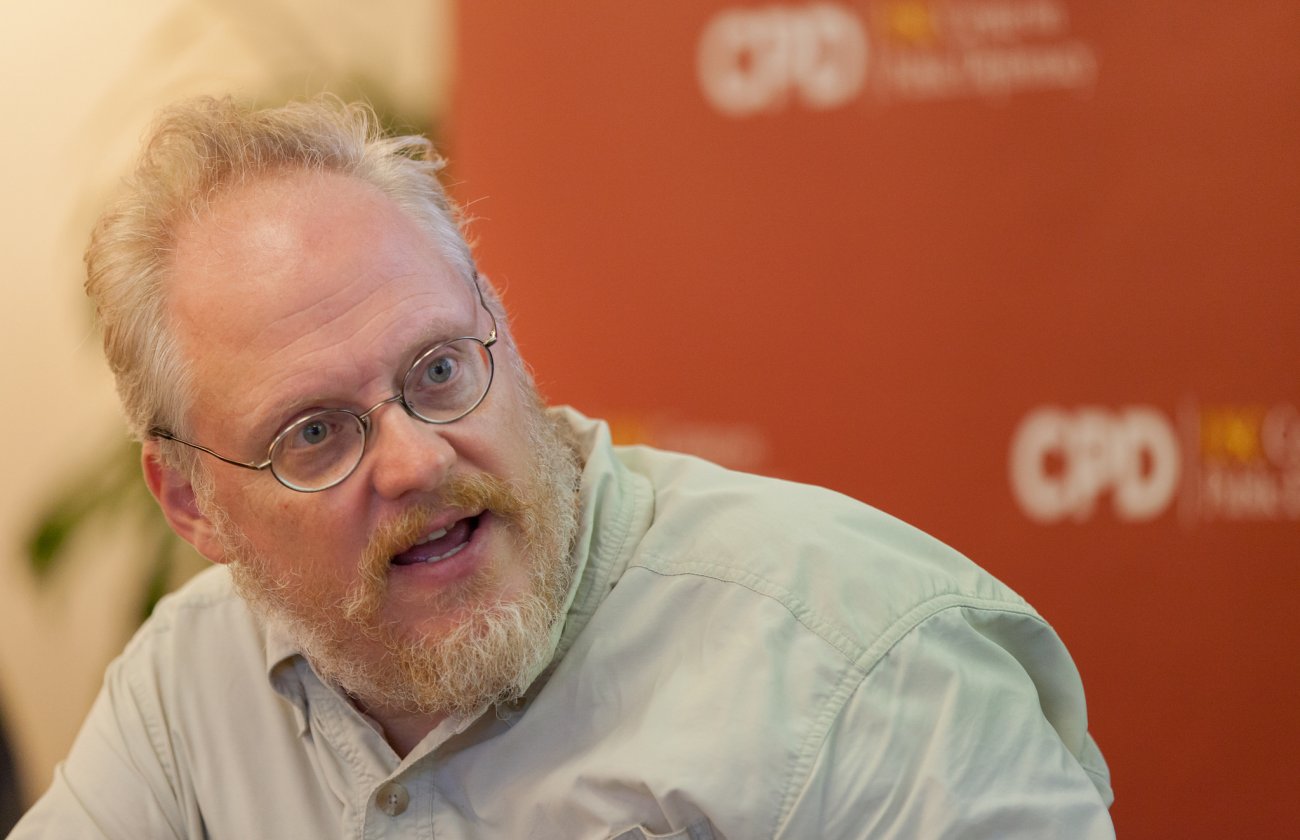The full story of Ruben Salazar was brought to life at USC Annenberg on Sept. 19, during a packed screening of a documentary directed and produced by USC Annenberg fellow Phillip Rodriguez. USC Visions and Voices presented the event, which included a lively panel discussion afterward with an audience of Salazar’s friends, co-workers, Chicano activists and longtime Angelenos who remembered his mysterious death.
Ruben Salazar: Man in the Middle untangles the contradictions and peels the layers of Salazar’s complicated life as a mid-century Mexican-American who became a pioneer minority journalist and then a symbol of the Chicano civil rights movement. The film also chronicles the filmmakers’ own investigation into the events surrounding Salazar’s death in 1970, when he was killed by an LA County sheriff’s deputy, and their successful push to reveal public records chronicling investigators’ response.
The film is set to air in primetime on PBS next year and to be featured by the Smithsonian Institute. Rodriguez and his co-producer, Jennifer Kobzik, are planning to enter it into film festivals and to tour schools and libraries with additional screenings.
“This story of Salazar had been considered to be a regional and ethnic story,” Rodriguez told the audience after the USC Annenberg screening. “And I thought it was a big, American story. We’re putting it on prime time (PBS), so people in Green Bay, Wis., and across the nation will have the opportunity to learn a little more about what the Mexican-American experience has been.”
The film is a capstone to an ongoing project by USC to document the life of Salazar, who was a columnist for the Los Angeles Times and then a news director for television station KMEX. USC Annenberg students and faculty members, in partnership with USC libraries, negotiated the release of his personal archives – ten boxes of memorabilia and writings dating back to his birth in Mexico in 1928. The items were curated, digitized and inserted by students into an image-rich timeline called the Ruben Salazar Project.
That project and the film seek to draw a full picture of Salazar’s life. The movie uses archived family photos, newspaper clippings, KMEX video and glimpses of his handwritten, personal writings to fill in the gaps of Salazar’s early life – from his family’s move from Mexico to El Paso, Texas to his first job. The film related one of the first stories he’s known for; at the El Paso Herald-Post in 1955, he pretended to be drunk in public so he could be arrested and report on conditions of the city jail. (The tale drew appreciative chuckles from the screening’s audience.)
Salazar also lived and worked in Northern California before moving to the Los Angeles Times in 1959. He eventually became a foreign correspondent and covered Mexico City as well as the Vietnam War. He returned to Los Angeles in 1969 to cover the growing Chicano movement.
In his late career, his voice began to emerge as a supporter of the Chicano movement, and he spoke out against civil rights violations and inequality faced by the community he was increasingly identifying with.
“He’s a mid-century Mexican-American who had assimilated to Anglo norms, which is what people did in those days,” Rodriguez said. “Then, in mid-life, he confronts this new nationalist movement among minorities. And this movement, which he’s asked to report on, forces him to answer questions about his own choices.”
A running theme of the film, Rodriguez said, is that transition. The idea was to delve beyond Salazar’s role as a symbol of the Chicano movement.
“On some levels it’s a murder mystery, but it’s also a very personal story about an internal struggle and self-reinvention. And that’s pretty poignant.”
As for the mystery, filmmakers partnered with MALDEF, the Mexican American Legal Defense Fund, to file a lawsuit that opened up law enforcement records – in an effort to shed light on the circumstances of Salazar’s death. The filmmakers also discovered the U.S. Department of Justice had conducted an independent, secret investigation but found no evidence that his death was more than an accident.
Salazar had reported being visited by Los Angeles police officers and being summoned to the LAPD police chief’s office, after his reporting in the LA Times. Soon after, Salazar was killed during the National Chicano Moratorium March against the Vietnam War. LA County sheriff’s deputy Tom Wilson, standing outside the Silver Dollar bar, fired a tear-gas canister that struck Salazar while he was inside with friends.
The film includes interviews with witnesses – and Wilson himself, along with the LA County Office of Internal Review.
“The LA Times did an exhaustive job of reporting on the case, shortly after his death,” Rodriguez said. “But in those days, law enforcement was really unaccountable to the extreme. There was only so much a reporter could find out.”
Salazar’s daughters, Lisa and Stephanie Salazar, attended the screening along with more than a dozen of the journalists and friends of Salazar who were featured in the film. Lisa Salazar thanked filmmakers afterward, saying that the film allows her father “to represent himself.”
Audience members stood in the aisles to catch a glimpse of the film, after the seats were filled. Spectators, many of whom were members of the Chicano movement or otherwise remembered Salazar’s influence, were eager to ask questions of panelists Rodriguez; George J. Sanchez, professor of American Studies & Ethnicity and History; and Thomas Saenz, president and general counsel of MALDEF. The panel was moderated by Yvette Cabrera, president of CCNMA: Latino Journalists of California.
“I think films like this don’t come that often, and that’s why there is such a big turnout,” said Manuel Huerta, of the East Side Heritage Consortium. “It’s exciting to see something that’s about a figure a lot of people know about – and to get a more humanized view of his life.”
View photos from the event here: http://www.flickr.com/photos/uscannenberg/sets/72157635701092894/.
Related:
· Filmmaker: City Projects
· The Ruben Salazar Project is available online here.
· For more information about the Ruben Salazar papers, visit the USC Libraries page.









